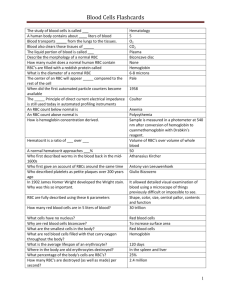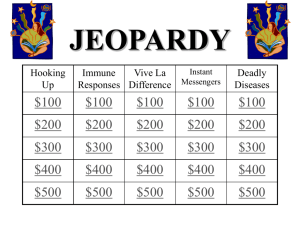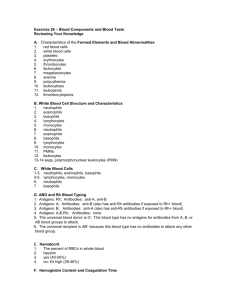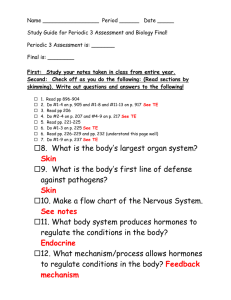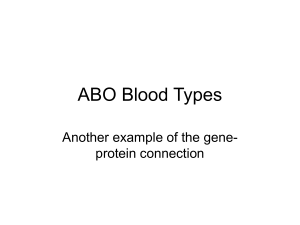Blood Cells Flashcards
advertisement
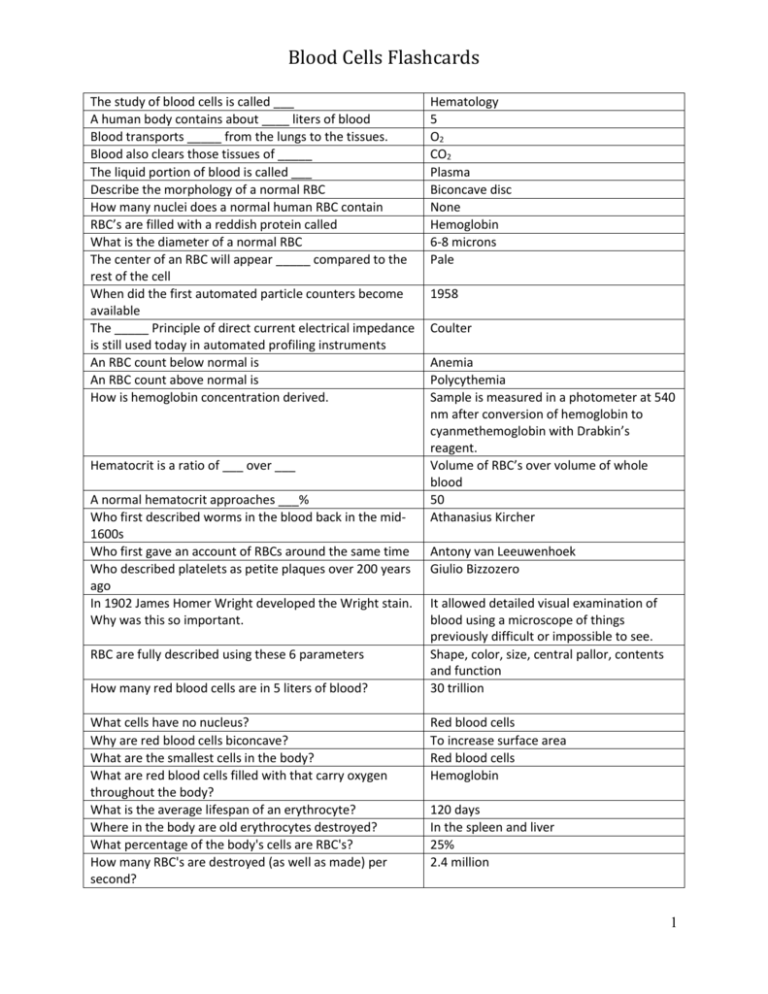
Blood Cells Flashcards The study of blood cells is called ___ A human body contains about ____ liters of blood Blood transports _____ from the lungs to the tissues. Blood also clears those tissues of _____ The liquid portion of blood is called ___ Describe the morphology of a normal RBC How many nuclei does a normal human RBC contain RBC’s are filled with a reddish protein called What is the diameter of a normal RBC The center of an RBC will appear _____ compared to the rest of the cell When did the first automated particle counters become available The _____ Principle of direct current electrical impedance is still used today in automated profiling instruments An RBC count below normal is An RBC count above normal is How is hemoglobin concentration derived. Hematocrit is a ratio of ___ over ___ A normal hematocrit approaches ___% Who first described worms in the blood back in the mid1600s Who first gave an account of RBCs around the same time Who described platelets as petite plaques over 200 years ago In 1902 James Homer Wright developed the Wright stain. Why was this so important. RBC are fully described using these 6 parameters How many red blood cells are in 5 liters of blood? What cells have no nucleus? Why are red blood cells biconcave? What are the smallest cells in the body? What are red blood cells filled with that carry oxygen throughout the body? What is the average lifespan of an erythrocyte? Where in the body are old erythrocytes destroyed? What percentage of the body's cells are RBC's? How many RBC's are destroyed (as well as made) per second? Hematology 5 O2 CO2 Plasma Biconcave disc None Hemoglobin 6-8 microns Pale 1958 Coulter Anemia Polycythemia Sample is measured in a photometer at 540 nm after conversion of hemoglobin to cyanmethemoglobin with Drabkin’s reagent. Volume of RBC’s over volume of whole blood 50 Athanasius Kircher Antony van Leeuwenhoek Giulio Bizzozero It allowed detailed visual examination of blood using a microscope of things previously difficult or impossible to see. Shape, color, size, central pallor, contents and function 30 trillion Red blood cells To increase surface area Red blood cells Hemoglobin 120 days In the spleen and liver 25% 2.4 million 1 Blood Cells Flashcards How many RBC's are made each hour? Where are RBC's made? Hereditary spherocytosis is a red cell membrane disorder What is the condition in which too many red blood cells are produced and requires therapeutic phlebotomy? What is any condition of red blood cells in which the blood's capacity for carrying oxygen is diminished? What is the lack of oxygen to the tissues called? 8.6 billion In the red bone marrow True Polycythemia What is the reduced blood flow to a tissue called? What are some of the causes of hypoxia? Ischemia Ischemia, malfunctioning hemoglobin, increasing altitude Reticulocytes in the blood Immature red blood cells True True Hemolysis Hereditary, acquired What is the characteristic sign of anemia? What are reticulocytes? Anemia can be caused by too few RBCs. Anemia can also be cause by iron deficiency. What is the rupture of RBCs? Hemolytic anemia can be ______, from autoimmune disorders or G6PD deficiency, or ________, from infections, or receiving the incorrect blood type in a transfusion. G6PD deficiency is hereditary and X-linked, so almost all are ______. G6PD is an ______ that is important for RBC metabolism. G6PD is the most common human enzyme deficiency. Pernicious anemia is also known as ___. Pernicious anemia is caused by a lack of vitamin B12 or intrinsic factor. After gastric bypass surgery, the stomach is no longer able to produce intrinsic factor, which is needed to absorb ______, which is needed to make _____ in RBCs. Without vitamin B12, the blood cells become fewer and larger than normal, or _______. Gastric bypass surgery patients must take vitamin B12 shots or sublingual supplements for the rest of their lives. What is Thalassemia? What is sickle cell disease? Which group of people that sickle erythrocytes present than other groups? What kind of infections that the sickle shape can prevent? What is hereditary spherocytosis? Anemia Hypoxia Male Enzyme True Megaloblastic anemia True Vitamin B12, hemoglobin Megaloblastic True A hereditary form of anemia where the RBCs have abnormal hemoglobin that deforms the cells A hereditary mutation resulting in one valine amino acid substituted for glutamic acid. people with African ancestry helps prevent malaria infections, but it also causes blood clots. The red blood cells shrink over time due to 2 Blood Cells Flashcards What is red blood cell (RBC) count? What does Hemoglobin (Hgb) measures? What does Hematocrit (Hct) measures? What is a quick screening test for anemia? How to perform the hematocrit test? What does hematocrit measures? What is the ratio of the hematocrit? What percentage is normal hematocrit What is a measurement of the average size of your RBCs? What is elevated when RBC are larger than normal? What is the term for larger than normal RBC? Name one condition where MCV is elevated What is the term for smaller than normal RBC? What is a calculation of the average amount of oxygencarrying hemoglobin inside a red blood cell? What is a calculation of the average concentration of oxygen on the hemoglobin molecules inside a red cell? What is the term for decreased MCHC values? What is the term for increased MCHC values? What is a calculation of the variation in the size of your RBCs? Having few RBC’s with various shapes is called? Having many RBC’s with various shapes is called? What is the practice of boosting the number of red blood cells in the bloodstream by giving an athlete an unnecessary blood transfusion in order to enhance athletic performance? Which athlete who won seven straight Tour de France titles confessed to using blood doping? What is the technique for determining which specific protein type is present on the RBC membranes? What are the proteins called when the cell membranes of the red blood cells carry certain types of proteins that problems with the red blood cell membrane. is a count of the actual number of red blood cells per volume of blood. Both increases and decreases can point to abnormal conditions. the amount of oxygen-carrying protein in the blood. the percentage of red blood cells in a given volume of whole blood. the hematocrit test A drop of blood is drawn up a small glass capillary tube and the tube is centrifuged to pack the red blood cells at the bottom with the plasma on top. the percentage of blood volume that consists of erythrocytes. the ratio of packed red blood cells to total blood volume. about 45% (46% for men and 38% for women.) Mean corpuscular volume (MCV) Mean corpuscular volume (MCV) Macrocytic Anemia caused by B12 deficiency Microcytic Mean corpuscular hemoglobin (MCH) Mean corpuscular hemoglobin concentration (MCHC) Hypochromia Hyperchromia Red cell distribution width (RDW) Anisocytosis Poikilocytosis Blood doping Lance Armstrong Blood typing Antigens (something that causes an allergic reaction) 3 Blood Cells Flashcards another person’s body will think is a foreign body and reject it? What are the 2 types of blood antigens? If a person with type A blood gets a transfusion of type B blood, what would happen? Which blood type is considered the universal donor? Why is this possible? Which blood type is considered the universal acceptor? Why is this possible? What is the rarest blood type? What protein does the term “positive” or “negative” refer to in blood typing. What occurs when an Rh- mother has an Rh+ fetus in her womb (from an Rh+ father), and she has antibodies to the Rh factor? If a woman is Rh- and pregnant the doctor will administer an injection of what at 18 weeks and again within 72 hrs after giving birth? About how old is a fetus when it begins making Rh factor? True or False: During an Rh- woman's first pregnancy an Rh+ baby is not at risk of Hemalytic Disease of the Newborn. What protein is another RBC antigen and similar to Rh factor; in that, it can cause Hemolytic Disease of the Newborn. Define Pathogen Bacterium, virus, fungi, yeast, protozoa, and worms are examples of what type of pathogen? What is an example of a non-biological pathogen? How many bacteria can fit inside a white blood cell? Where do bacteria live in the body? How do bacteria cause harm? How many viruses can fit inside the nucleus of one white blood cell? How many viruses can fit inside the nucleus area of a Type A and Type B the donated blood will clump in masses (coagulation), and the person will die. O negative. It is possible because there are no antigens on the blood cell. AB positive. This is possible because the plasma does not contain antibodies to A or B or Rh antigens. AB negative Rh Factor her antibodies will attack the red blood cells of the fetus because her body detects the Rh protein on the baby’s red blood cells and thinks they are foreign objects. This is called Hemolytic Disease of the Newborn (HDN). Rhogam 18 weeks True; during the first birth (or miscarriage), the placenta tears away and that’s when the baby’s blood cells get into the mother’s bloodstream. This begins the immune response. The Kell protein. People either have big K or little k proteins. Most people have little kk. If one parent has big K (either Kk or KK), the child can get Hemolytic Disease of the Newborn. Something that causes a disease. Biological Pathogens Toxic chemicals, asbestos are two examples. Bacteria are so small that hundreds of them can fit inside one WBC. They usually do not invade cells, they live between cells of the body, using nutrients in the area. By secreting toxins Thousands Hundreds 4 Blood Cells Flashcards bacterium? Where do viruses live in the body and why? What happens when a body cell has been invaded by a virus? What is an antigen? What are some examples of non-biological antigens? List the Leukocytes They always try to invade body cells because they need host DNA or RNA to replicate The entire host cell must be killed by a white blood cell. An Antigen is anything that can cause an immune response, not necessarily a biological pathogen. Pollen, dust, grass, or anything that a person is allergic to. 1) Basophils -Mast Cells 2) Eosinophils 3) Neutrophils 4) Monocytes -Macrophages 5) Lymphocytes -B cells -T cells What percentage of all Leukocytes are Basophils? What is secreted by Basophil granules and why? • • What interferes with the function of Basophils? What is a Basophil that leaves the blood vessel and enters the tissues? What percentage of Leukocytes are Eosinophils? What roles do eosinophils play? • • Which is the most numerous White Blood Cell? Which White Blood Cell is the first to respond to infection? What roles do neutrophils play in response to infection? • • How many lobes does the nucleus of an Eosinophil have? How do Neutrophils contribute to immunity? When bacteria have capsules, they are harder to phagocytize. What action makes this process easier? • • 0.5 % Histamines. It causes vasodilation so more WBCs can get to the infection site. Antihistamines Mast Cell 1-4% Ending allergic reactions and parasitic infections. They increase in numbers during these conditions (Eosinophilia) Neutrophils Neutrophils 1) Phagocytize and destroy bacteria 2) Also destroy bacterial toxins in body fluids • 2-6 lobes Engulfing bacteria and foreign bodies (thorns, dirt) in a process called phagocytosis. They release the contents of lysosomes onto invader, dissolving it. Opsonization by antibodies 5 Blood Cells Flashcards What has some bacteria around them developed as a defense against phagocytosis. True or False: If a bacteria develops a capsule, neutrophils nor macrophages can not engulf that particular bateria. The process of facilitation of phagocytosis is called? What is the structure called when an invading bacteria has the antibody attached to its cell membrane? If a bacterium does not have a this structure, the neutrophil can destroy it without opsonization. When a capsule is present around a bacterium, what two that best work together are needed to kill the bacteria? This type of cell comprise about 5% of all WBC’s. This type of leucocyte use antibodies for opsonization. They phagocytize bacteria,old cells, and foreign bodies. When monocytes leave the bloodstream and enter the tissue, they are called? What cells are considered to be the most numerous of white blood cells? True or False: There are more macrophages in the tissue of the body than they are everywhere. Neutrophils live only a few days where as Monocytes/Macrophages live for how long? What cells phagocytize bacteria until they die? What type cell phagocytize and then take pieces of dead bacteria and present them to lymphocytes so a larger immune response can occur? What are the two type of phagocytes? What are Lymphocytes mostly needed to do? Neutrophils and macrophages main function is not to phagocytize viruses, but to what? What do macrophages have that make them recognize the surface of the pathogen’s cell membrane? When macrophages phagocytize bacteria, pop their lysosomes onto it and dissolve it, what do the macrophages do to their own cell membrane and for what reason? Macrophages present pieces of T cell lymphocytes and that T cell will present it to a what type of lymphocyte? The B lymphocyte feels the shape of the bacteria pieces, and the B lymphocyte can them launch an attack in the rest of that type of bacteria still alive in the body. What is this process called? What is a lymphocyte? There are two types of lymphocytes. What does one do Capsule 1 Opsinization Antigen-antibody complex Capsule Neutrophil and antibody Monocytes Monocytes Macrophages Neutrophils 1 Monocytes/Macrophages live for a few months. Neutrophils Macrophages Neutrophils and macrophages Kill off body cells infected by viruses. To phagocytize bacteria Surface receptors Macrophages place a piece of the bacteria’s cell membrane on it’s own cell wall until the macrophage finds a lymphocyte to present it to. B cell lymphocyte Antigen presentation Lymphocytes are cells which produce antibodies to kill any pathogens which invade the body. One makes antibodies and the other 6 Blood Cells Flashcards and what does the other do? What are the two main classes of lymphocytes? Where do the B cells originate from? B cell that has not been presented to an invader is called a? After a B cell has been introduced to an invader, the B cell will mature into a what? A mature plasma cell fights infection by producing what? After the war of infection is over, the plasma cell will mature into a queen called a what? Where do the T cells originate from? Who do the T cells attack directly. What does a B cell mature into once they have been presented to? What is a function of a Plasma Cell? What is the function of the antibody from a Plasma cell? How do the antibodies of a Plasma Cell kill an attacking cell? How do the antibodies of a Plasma Cell kill an attacking cell? How do the antibodies of a Plasma Cell kill an attacking cell? Define the term Mononucleosis What is the cause of Mononucleosis? What is a characteristic of Mononucleosis? What is Lymphangitis? What is a visual characteristic of Mononucleosis? What is the function of a T-cell? How does a T-cell directly destroy bacteria? How does a T-cell directly destroy a foreign cell? Host body cells that have become infected with viruses may be killed by what type of cell? What are characteristics of a T-cell regarding the killing of an invading cell? What is the relationship of a T-cell and antibodies? Which type of patient is at risk due to the function of Tcells? engages in direct combat with viruses. B cells and T cells Bone marrow Virgen B cell Plasma cell Antibodies Memory cell Thymus gland They attack foreign cells including organ transplants. Plasma Cell Secrete Antibodies Kill the attacking cell They attach to bacteria and pop the cell membrane They attach to encapsulated bacteria to help neutrophils and macrophages to phagocytize them They agglutinate (clump all over the bacteria, binding their receptor site so they cannot cause harm) A disorder of B-cell lymphocytes The Epstein Barr Virus Inflammation of lymph vessels(lymphangitis) Lymph vessel inflammation; usually from infection Infected lymphocytes have a scalloped edge where they touch RBC’s Coordinate the immune response by recruiting other white blood cells. Popping their cell membrane Popping their cell membrane T-cell They do not need to phagocytize the invading cell, they just kill the cell and the macrophage dissolves the debris. T-cells do not need the assistance of antibodies in order to destroy an invading cell. Organ transplant patients 7 Blood Cells Flashcards What type of cell attacks the organs of an organ transplant patient? What types of drugs are designed to inhibit the action of T-cells? What cell is attacked by the HIV (AIDS) virus? Where do T-cells originate from? What does the Thymus Gland secrete? What happens when a T-cell becomes immunocompetent? What are the three types of T-cells? What is the function of a Cytotoxic (killer) T-cell? What are the functions of a Helper T-cell? What happens when a T-cell presents a macrophage’s antigen to a B-cell? What are the functions of a Suppressor T-cell? What type of B-cell remembers how to destroy a pathogen that has once invaded the body? What is the function of Memory B-cells? Why can Memory B-cells react to remembered pathogens faster? True or False? A pathogen can get past the body’s physical and chemical barriers and the inflammation response. What are pathogens engulfed by? What is another word for macrophage? What does the macrophage release onto a bacterium to dissolve it? True or False? There are still some pieces of the bacterium’s cell membrane left. What are surface proteins of macrophages also known as? Where does the macrophage force the antigens of the bacterium? True or False: T-cell Immunosuppressive drugs T-cell Thymus Gland Certain hormones which can cause T-cells to become immunocompetent Makes the cells mature and start to work Cytotoxic (killer), Helper, and Suppressor Tcells Go out and directly kill bacteria or infected host cells Release chemicals called “cytokines” to call more white blood cells of all types to join the war. Present the macrophage’s antigen to a Bcell. Produce antibodies against that particular bacteria Stop the immune process when it is over Tell plasma cells to “remember” how to destroy that specific pathogen. Memory B-cells React to remembered pathogens faster the next time it invades. Memory B-cells already have the proper antibodies stored up for that pathogen. True Macrophages Neutrophil The contents of its lysosomes True Antigens To it’s own cell surface. False. 8 Blood Cells Flashcards B-cells touch these surface antigens to make a copy of their shape. Which cell is presented the surface antigen? B-cells create ________ against pathogens. True or False? Helper T-cells multiply and have two main roles Helper T-cells activate which type of cells? What does the Helper T-cell “tell” the B-cells to do? What do the B-cells turn into? Plasma cells multiply and produce _________ to ________ a specific pathogen What is the second role of the Helper T-cells? What do Killer T-cells secrete? True or False? Killer T-cells can destroy the pathogen itself (bacteria) Why would a Killer T-cell destroy an entire body cell? When an immune response is over, what kind of cell stops the process? What do Supressor T-cells “tell” some B-cells to do? B-cells (plasma cells) now become __________. What is leukemia? And what kind of cell does it involve? What happens when one stem cell does not function properly? What is a result from a decrease of WBC? Where are the immature white cells sent to? Define Leukemia True or False? Even though WBC count is high, they are all immature forms Leukemia is a form of cancer classified as a disorder of ________ where too few mature ______ are made True or False? Lymphoblastic is defined as too many mature lymphocytes Too many immature neutrophils is defined as? What do people with severe leukemia need transplated? Before a bone marrow transplant, what has to happen with the recipients WBCs? Correct cell: Helper T-cells B-cells Antibodies True B-cells and Killer T-cells Helper T-cells tell B-cells how to neutralize the pathogen by presenting the pieces of the bacterium cell membrane. Plasma cells Antibodies; neutralize To activate the Killer T-cells. Cytokines True It is infected with a virus Suppressor T-cells Suppressor T-cells “tell” some B-cells (plasma cells) to “remember” how to destroy that specific pathogen Memory B-cells Cancer of the blood involving the white blood cells It will make huge amounts of clones of itself which do not function the right way, resulting in not enough normal WBC being made The body cannot fight infection The bloodstream Leukemia can be defined as too few mature WBC True Leukocytes; WBCs False. Lymphoblastic is defined as too many immature lymphocytes Myeloblastic A bone marrow transplant The WBCs of the recipient have to be killed off with a medicine since they are mostly malfunctioning. 9 Blood Cells Flashcards The donor usually has a small cylinder of bone removed from their _____ How is the bone marrow given to the recipient? True or False? The new WBC’s may kill the patient or it may save their life Define WBC count True or False? An increase or decrease is WBC’s can be significant Define White blood cell differential How many different types of WBC are there? Name the different types of WBC’s Neutrophils are also known as Excess neutrophils is defined as Too few neutrophils is defined as Define thrombocytophilia Define thrombocytopenia How long do Lymphocytes live How long do Erythrocytes live How long do Platelets live How long do Monocytes live How long do Neutrophils live Antibodies are also known as what? What are antibodies made by? What are typically basic structural unit? What shape does the antibody form? What are the tips of the “Y” ? What does the stem of the “Y” do? What is the hypervariable region? What is the advantage of the hypervariable region? What is the function of IgD? What is the function of IgE? What is the function of IgG? Hip I.V. True A count of the actual number of white blood cells per volume of blood. True It identifies the types of white blood cells present Five Neutrophils, lymphocytes, monocytes, eosinophils, and basophils. Segs, PMNs, granulocytes, grans Neutrophilia Neutropenia Excess platelets Too few platelets can live a lifetime 4 months about 2 months 30 days about a week immunoglobulins, abbreviated Ig are proteins made by plasma cells. each with two large heavy chains and two small light chains to form a unit shaped like the letter “Y” have receptors that are specific for a particular antigen can be grasped by a phagocyte. Small region at the tip of an antigen allowing millions of antibodies with slightly different tip structures, or antigen binding sites, to exist allows the immune system to recognize an equally wide diversity of antigens initiation of immune response stimulates allergic reactions, good for worm infections highest concentration in blood, highest amounts in most secondary responses. Indicates infection was in the past. It can also cross the placenta. 10 Blood Cells Flashcards What is the function of IgA? What is the function of IgM? Why are people sick more often as children than in their 20’s and 30’s? What is Myasthenia gravis (MG)? What are symptoms of MG? What are platelets made from? What happens when a platelet encounters a broken blood vessel? Platelets are responsible for what? What is a platelet? What is the primary function of a platelet? Where are platelets located? What Term means lack of platelets? Primary vitamin that is needed for blood clotting factor? Where is vitamin K found? What is a Therapeutic use for Aspirin What is hemophilia? What is a thrombus? What is an Embolism? What is platelet count? What can thrombocytophilia and thrombocytopenia indicate? secretory Ig, found in secretions, highest concentration in body produced first, best at C’ activation. Indicates infection is current we build up many varieties of memory lymphocytes during childhood, providing immunity from more and more antigens during adulthood autoimmune disease where antibodies destroy or block receptors for acetylcholine, a neurotransmitter. Causes flaccid muscle paralysis Pieces break off of a megakaryocte and are known as platelets it uses clotting factors (made in the liver and circulating in the blood) to form a web to clots blood. clot (thrombus) formation Is the cell fragment that is broken off from megakaryocytes. Function in clotting of blood In the plasma called Clotting factor in order for then to become activated form a clot. They are found in Fibrin; it is made from Fibrinogen. Thrombocytopenia; it is abnormal lowing concentration of platelets. Vitamin K Found in green, leafy vegetables. Can help blood clots by blocking the action of platelets. It A hereditary disease of males, where they are unable to clot properly because they are missing some clotting factors. When they get even a slight bump or bruise they have to have an intravenous infusion of clotting factors or they will bleed to death. A clot in a vessel A thrombus that broke away and travels in the blood stream. It usually lodges in a smaller blood vessel and blocks circulation distal to that point. The platelet count is the number of platelets in a given volume of blood. Both increases (thrombocytophilia) and decreases (thrombocytopenia) can point to 11 Blood Cells Flashcards What is the Mean Platelet Volume and how does it relate to the age of platelets? What are the uses of PT and PTT tests and which are the coagulation factors they evaluate? How Heparin is used as anticoagulant drug therapy? What primary diseases are monitored by CBC and what are the parts of a Complete Blood Count? abnormal conditions of excess bleeding or clotting. Mean platelet volume (MPV) is a machinecalculated measurement of the average size of your platelets. New platelets are larger, and an increased MPV occurs when increased numbers of platelets are being produced. The PTT test is used to investigate unexplained bleeding or clotting. It may be ordered along with a PT (Prothrombin Time) test to evaluate hemostasis (the process of clot formation). The PTT evaluates the coagulation factors XII, XI, X, IX, VIII, V, II (prothrombin), and I (fibrinogen). A PT test evaluates the coagulation factors VII, X, V, II, and I (fibrinogen). By evaluating the results of the two tests together, a doctor can gain clues as to what bleeding or clotting disorder may be present. These tests are used to monitor heparin anticoagulant therapy. Heparin is a drug that is given intravenously (IV) or by injection to prevent and to treat blood clots. IV’s are also flushed with heparin to prevent clot formation. When it is administered for therapeutic purposes, it must be closely monitored. If too much is given, the treated person may bleed excessively; with too little, the treated person may continue to clot. The complete blood count or CBC test is used as a broad screening test to check for such disorders as anemia, infection, and many other diseases. It is actually a panel of tests that examines different parts of the blood and includes the following: White blood cell (WBC) count White blood cell differential Red blood cell (RBC) count Hemoglobin Hematocrit Mean corpuscular volume (MCV) Mean corpuscular hemoglobin (MCH) Mean corpuscular hemoglobin concentration (MCHC) 12 Blood Cells Flashcards Red cell distribution width (RDW) platelet count PT, PTT (separate test from CBC) What is septicemia? Septicemia (aka bacteremia or toxemia) is the condition when bacteria invade the body and circulate in the blood. What entry points bacteria can use in order to gain access Bacteria can enter the bloodstream as a to the blood? severe complication of infections (like pneumonia or meningitis), during surgery (especially when involving mucous membranes such as the gastrointestinal tract), or due to catheters and other foreign bodies entering the arteries or veins (including intravenous drug abuse). What consequences the presence of bacteria have in the Bacteremia can have several consequences. blood? The immune response to the bacteria can cause sepsis and septic shock, which has a relatively high mortality rate (kills 1 person in 5). Bacteria can also use the blood to spread to other parts of the body (which is called hematogenous spread), causing infections away from the original site of infection. Examples include endocarditis or osteomyelitis. What is the treatment of septicemia? Treatment is with antibiotics, and prevention with antibiotic prophylaxis can be given in situations where problems are to be expected. What are the stem cells? STEM CELL: A cell that has not matured and differentiated yet. What are the advantages of stem cells and why would An embryo has lots of stem cells which research use embryos as stem cell sources rather than the have not decided to become a nerve cell, placenta? muscle cell, liver cell, etc. Stem cells become the type of cell the body needs. The placenta of a newborn infant has many of these stem cells, too, but not as many as an embryo. That’s why people want to research stem cells on embryos; there are more stem cells there. What is the first step for a stem cell? To differentiate in order to decide which cell it belongs to. What is hematopoiesis? blood cell formation How many new blood cells are formed each day? 100 billion Where are plasma proteins made? In the liver Where are blood cells made? In the red bone marrow/spongy bone Where is red bone marrow located? Epiphyses of long bones, girdles (clavicle, scapula pelvic bones), axial skeleton 13 Blood Cells Flashcards What are characteristics of yellow bone marrow? What is released into the bloodstream once completely mature? Where are blood cells destroyed once they are old? Where do T cells mature? What cells originate from blood stem cells? What happens when a RBC loses its nucleus? What are reticulocytes? What is the relationship between lymphoblasts and lymphocytes What are myeloblasts? What is Leukemia? What is an inflammation reaction? What are the four signs of inflammation? What causes redness in the stages of inflammation? What causes heat in the stages of inflammation? What causes swelling in the stages of inflammation? What causes pain in the stages of inflammation? What are the two types of immune response? What are the two types of Adaptive Immunity? What is active immunity? (sternum and vertebral bones) Contains many fats cells, located in long bones of adults, has nothing to do with forming blood cells. blood cells in the spleen and the liver the thymus gland erythroblasts: red blood cells lymphoblasts: lymphocytes myeloblasts: all other white blood cells it gains room for more hemoglobin cells with some bits of nucleus for about two days Lymphoblast give rise to lymphocytes These are the stem cells that mature into the other leukocytes. Leukemia is cancer of the stem cells When you get stuck by a thorn or have an infected cut, the body goes through a series of events called an inflammatory reaction. – Redness (erythema or rubor) – Heat (calor) – Swelling (edema or tumor) – Pain (dolor) Redness is caused from the blood vessels dilating to allow more blood flow to the area. Within the blood are platelets to clot the blood, proteins to repair the damage, and macrophages, which are white blood cells that eat up the foreign body, bacteria, or the dead cells. Heat is caused because of the extra amount of warm blood flow to the area. Swelling is caused from the plasma that leaks out of the swollen blood vessels. Pain is caused from the pressure of the extra fluid pressing on nerves in the area. The immune response is divided into two parts: Innate Immunity (WBC) and Adaptive Immunity (Antibodies) Active immunity and Passive immunity Active means the person’s own body makes the antibodies. Naturally Acquired 14 Blood Cells Flashcards – What is naturally acquired active immunity? In naturally acquired active immunity, which cells secrete these antibodies, how long can they live, and how do they attack? Can you get the same cold virus twice? Which diseases may kill you at first exposure? What is a vaccine? What is the point of vaccination? What is an example of Artificially Acquired Active Immunity? What does passive in Passive Immunity mean? What is an example of naturally acquired immunity? What are the two types of passive immunity? What are two examples of artificially acquired immunity? Are active or passive immunity for life or short life? What are allergies? The body is naturally exposed to an infectious agent and launches an immune reaction Artificially Acquired The person is injected with a weakened (attenuated) or killed organism, as found in a vaccination It is when the body is exposed to an infectious agent and the body has to work to produce antibodies which specifically attack that infectious agent. The white blood cells secrete these antibodies which will continue to circulate sometimes for years, ready to attack that type of bacteria and cause them to pop like a balloon before the body can become sick. No, you will become immune to it. Your next cold is from a different virus. Polio, diphtheria, tetanus, and influenza. It is an altered or attenuated form of the virus that the body recognizes as foreign, but they can’t cause disease. If the person is exposed to the real organism later, the antibodies are already there to kill it off without the body getting sick. An example is when a child is vaccinated against measles as a baby, so when he gets to school and is exposed to the disease, he doesn’t get sick. PASSIVE means the person’s body does not have to make the antibodies. An example is the passing of antibodies from mother to infant in breast milk. Naturally acquired or artificially acquired The first example is when a person receives an infusion of antibodies from someone else. The second is an example of an ebola survivor that donates his blood to another infected person. Active immunity is long-lived, and may last for years or even a life time. Passive immunity is short lived, and may last only for a few months. It is a hypersensitivity to substances such as pollen or animal hair that would not 15 Blood Cells Flashcards What are the two types of allergic responses? What is an immediate allergic response? What will stop an allergic reaction for peanuts or seafood? What is a delayed allergic response? What is an example of a delayed allergic response? What is a wheal-and-flare reaction? What are some examples of symptoms of an allergic reaction? What is localized anaphylaxis? What is the definition of pruritis? What is the definition of urticarial? What is allergic rhinitis? What is atopic dermatitis? What are the symptoms of an allergic asthma attack? What is an autoimmune disease? ordinarily cause a reaction. Immediate and delayed. A reaction that occurs within seconds of contact with the thing causing the allergy. A shot of epinephrine will stop the reaction. When the body’s first exposure to the substance will not cause a reaction, but all exposures afterward will trigger the response. Not itching the first time you touch poison ivy. Pruritis (itching), erythema on the skin bronchoconstriction mucous secretion vasodilation (shock) A reaction limited to the site of allergen exposure Itching Hives Hay fever Eczema airway edema mucous secretion inflammation A hereditary problem where the body thinks its own tissues are foreign bodies, and it constantly tries to kill off its own tissues. 16
